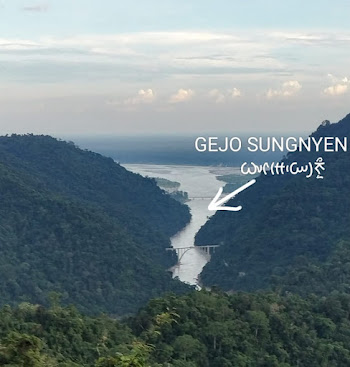Saga of 'GEJO SUNGNYEN ᰃᰤᰦᰙᰨᰠᰵᰪᰉᰰᰬ, and SAFUK ᰠᰶᰑᰫᰭ
The mighty river Teesta gushes through the mountains only to simmer down at this point called 'GEJO SUNGNYEN'(Commonly known as Nindray pani in Nepali) .
Chronicles tell us that a Lepcha king during the late 16th century by the name 'Rongzi Punu' ᰛᰩᰵᰙᰧ ᰎᰍᰨ in one of his tax collecting journeys to the southernmost border of the Lepcha kingdom at Jalpesh in the Terrai, Rongzi Punu met the beautiful princes called Gejo ᰃᰤᰦᰙᰨ from “Jawlasi.” ( now Jalpaiguri ). He was mesmerised with her charms. In a quest to wait for her, he cleared a forest in Terrai “Safok," which is now Sevok near Silliguri and remained there. ( Literal translation of Safok in lepcha means to clear the forest) . He stayed there for quite some time to woo the princess Gejo (also known as Jawlasi Pundi among the Lepchas) until he won the heart of the princess from Jalpaiguri (A Rajbanshi princess).Months later the bridegroom's party camped in Safok by the river side.
After winning the hand of the princess Gejo by the Lepcha king Rongzi Punu in Jalpaiguri they
came back and rested for the night in Safok.
In the wee of the morning the baraat / varayatra party was attacked by the 'Paromu' ᰎᰦᰛᰨᰕᰫ, (then Paro penlop now a part of Bhutan) who also wanted to marry the princess of Jalpaiguri. A fierce battle broke out, Rongzi Punu and Gejo had to run away leaving behind all the marriage gifts such as gold and silver that was presented to the newly weds.
Gejo in haste could only pick up a bag containing maize ᰀᰰᰪᰗᰵᰫ, paddy ᰙᰨ, millet ᰕᰩᰵ and other various seeds of vegetables while running along with Rongzi Punu. After several hours they reached a place by the river in between the forest where the rooster crowed at the dawn of the day. Lepchas call it 'hikboo riyang boo lyang' and this particular place is called 'RIYANG' ᰛᰧᰚᰴᰦ these days.
Prior to wedlock, Lepchas were basically hunters in the forest and did not know much about cultivation and farming, until the princess of Jalpaiguri brought the seeds from the plains. Now that she had brought the seeds, the princess did not know the right time and season to plant the seeds . The princess, who now was the Queen of Ney Mayelyang (Lepcha country) then entrusted River Teesta with the work of taking a message to her mother down in the plains,asking her the exact time to sow seeds in her new home. The river listened to her patiently and motionlessly. Even today the water at the place where the queen had stopped to entrust the river with the work of a messenger is motionless and silent. It is this place the Lepchas call “Gejo Sungnyen” ( the place where the river silently listens to the queen, Gajo).
The mother of the princess in Jalpaiguri sent her message back through the Cranes (ᰀᰲᰪᰅᰩᰭ ᰑᰨ Kurnwoak fo )
The Lepchas sow seeds when the Cranes return to the north in the beginning of Summer.
The season falls in March/April (Thun lavo ᰋᰰᰶ ᰜᰟᰨ) to plant the seeds . Till date the Lepchas still waits for these birds to sow the seeds starting from maize .
It was the Rajbanshi people of the tarai region who taught the Lepcha people about cultivation and farming. Marriages between Lepchas and the Rajbanshi people were not a new thing in the past.

No comments:
Post a Comment